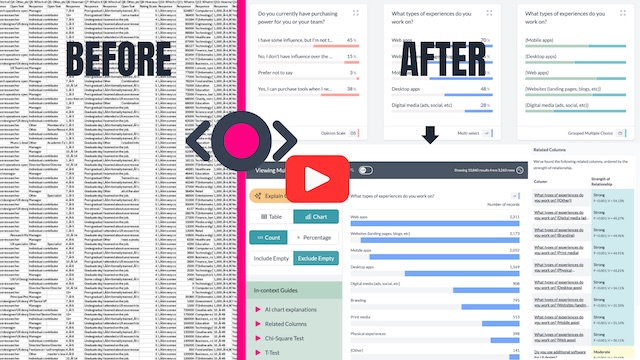Sample Size vs. Margin of Error: Where the Math Actually Helps
In research, there's a lot of gray area.
Is that spike in complaints meaningful, or just a fluke? Did users actually prefer version B, or were they just reacting to the colors?
But when it comes to how many people you need to hear from to make a confident call - statistics has a pretty clear answer.
That's where sample size and margin of error come in.
And unlike plenty of other areas in research, this is one where the math is actually useful, straightforward, and worth trusting.
Let's break it down.
How Confident Is "Confident"?
Say you survey 385 people in the U.S., and 60% say they've heard of a new product.
You might be tempted to round that up to "about two-thirds of the country knows about it" - but hold up. That number isn't the full story. It comes with built-in wiggle room, and that wiggle room is what gives it meaning.
With a sample of 385 and a 95% confidence level, your margin of error is ±5%.
So what you're really saying is:
"We're 95% confident the true number is between 55% and 65%."
That's the power of these calculations.
They tell you how much trust to put in your results - not just what the results are.
Sample Size: Why 385 Is Often Enough
Here's the part that surprises a lot of people:
For most large populations - think entire countries, major user bases, or all customers - the number of people you need to survey doesn't scale linearly.
To estimate proportions in the full U.S. population (about 332 million people), a sample of just 385 is statistically enough - if you're okay with a ±5% margin of error and 95% confidence.
Yes, really.
Once your population size gets past ~20,000, the required sample size barely changes.
The math accounts for it.
What affects your sample size more is:
- Margin of error: Smaller error = more people needed
- Confidence level: 99% confidence requires more than 95%
- Expected proportion: Estimating a rare behavior (like 1% incidence) can skew things
Let the calculator do the math.
But knowing which inputs matter - and which don't - makes the whole thing less mysterious.
The 50% Assumption (And When to Change It)
Most sample size calculators default to an expected proportion of 50%. Why?
Because it's the most conservative assumption.
A 50/50 split has the most variability. That means your required sample size will be the largest.
If the real answer is closer to 10% or 90%, the margin of error shrinks - and you can get away with a smaller sample.
If you've got prior data (e.g., only ~20% of users click a certain button), plug that in instead.
It'll give you a more tailored - often smaller - sample size.
Wait - What If I Already Collected the Data?
Maybe you didn't plan your sample size - you just got 250 responses.
Totally fine.
The flip side of the equation is figuring out what margin of error your sample gives you. Just switch to "Calculate Margin of Error," plug in your numbers, and it'll show your range.
You can still say something - just be clear about how precise it is.
What If I Need Subgroup Results?
Here's where the "385 rule" starts to get fuzzy.
If you're slicing your results - Gen Z vs. Boomers, power users vs. casual browsers - your effective sample size per group shrinks.
That means:
- Your margin of error increases for each subgroup
- Or: You need a larger overall sample to get reliable subgroup comparisons
The calculator doesn't know your segmentation plan - but you should.
A 1,000-person survey might be overkill for one stat - but just right for five personas.
Real-World Example: Averages and Ratings
Sample size and margin of error aren't just for yes/no questions.
Say your average satisfaction score is 4.2 out of 5 from a sample of 400. What does that mean?
Statistically, it means you're confident the true average falls in a range - just like with proportions.
If your margin of error is ±5%, that's a range of 4.0 to 4.4.
Small, but meaningful - especially if you're comparing versions, competitors, or time periods.
The Takeaway: Don't Guess - Calculate
In research, plenty of decisions involve judgment, context, and messy tradeoffs.
But sample size and margin of error aren't one of them.
This is one area where the math is actually well-behaved.
Use it.
Use it to:
- Plan smarter studies
- Defend your findings
- Know when "close enough" really is enough
And if you want the numbers fast, without the formulas?
The calculator is here for that.

